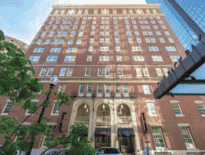
MBTA executives, community leaders and advocates celebrated the opening of Columbus Avenue’s center-running bus lanes with a ribbon-cutting event on Nov. 4, 2021. Photo courtesy of the MBTA
City and state officials gathered in Boston’s Jamaica Plain neighborhood to celebrate the opening of a new piece of transit infrastructure that, they say, shows the way forward for transit improvement projects region-wide.
The mile-long, center-running bus lanes on Columbus Avenue will speed thousands of riders on three heavily-used MBTA routes, plus school buses, past traffic and will knock as much as seven minutes off a rider’s travel time and make bus travel significantly more reliable. The $14 million project also involved consolidating some bus stops into four new, Green Line-like platforms with shelters, screens tracking bus arrivals and crosswalk islands to help pedestrians cross the busy street more safely.
“Here on Columbus Ave., a vision for the future of our bus system has taken hold, one where our riders can expect more reliable service, greater accessibility, improved safety, and enhanced customer amenities. We are proud to have partnered closely with the city of Boston to make this vision a reality, one that our riders will benefit from for years to come,” MBTA General Manager Steve Poftak said in a statement. “This project is just the first step. We are excited to continue to work with the City of Boston and our other municipal partners to roll-out similar projects in the years to come; extending similar benefits to riders systemwide.”
The center-running lanes have the added benefit, over the curb-side lanes that have been popping up in some Boston suburbs in recent years, of decreasing interference from turning, parking or double-parked cars. The MBTA says center-running lanes are also generally safer for all road users and help calm car traffic by making speeding less appealing to drivers.
The lanes also give a boost to racial equity efforts, transit advocates said.
“This project has been a major step forward for the MBTA and Boston when it comes to closing our system’s transit equity gap,” LivableStreets Alliance Executive Director Stacy Thompson said in a statement. “Nine in 10 Route 22 riders are people of color, and they have disproportionately longer commuters compared to their fellow white bus riders. Every minute we can give back to riders on the 22 or the 29 or the 44 is a valuable investment toward making a more just, equitable and sustainable city. We look forward to continuing to advocate for more transit improvements on behalf of riders in the months and years to come.”
The city plans to expand the lanes, which currently run from Franklin Park north to Jackson Square, all the way to the major bus hub at the Ruggles Orange Line station. The lanes will also offer a template for similar improvements on roads like Blue Hill Avenue and the Lynnway to deliver significant improvements in public transit service at low prices compared to building new subways.
“I was so excited to join for the launch of the new Columbus Avenue bus lane. This design is the first of its kind in all of New England and it will serve over 8,000 daily bus riders who rely on the 22, 29, and 44 bus routes to connect to the MBTA transit system. These routes have had consistently high ridership throughout the pandemic,” Boston’s acting Mayor Kim Janey said in a statement. “Thank you to the MBTA, the Boston Transportation Department and all of the community members and organizations that have come together to make our transportation safer, more accessible and more equitable.”

Columbus Avenue’s bus lanes are the first center-running bus lane facility in the MBTA service area and in New England. Photo courtesy of the MBTA






